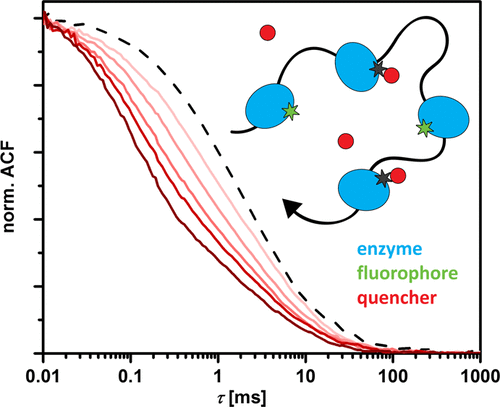当前位置:
X-MOL 学术
›
Acc. Chem. Res.
›
论文详情
Our official English website, www.x-mol.net, welcomes your
feedback! (Note: you will need to create a separate account there.)
Diffusion Measurements of Swimming Enzymes with Fluorescence Correlation Spectroscopy
Accounts of Chemical Research ( IF 16.4 ) Pub Date : 2018-08-30 00:00:00 , DOI: 10.1021/acs.accounts.8b00276 Jan-Philipp Günther 1, 2 , Michael Börsch 3 , Peer Fischer 1, 2
Accounts of Chemical Research ( IF 16.4 ) Pub Date : 2018-08-30 00:00:00 , DOI: 10.1021/acs.accounts.8b00276 Jan-Philipp Günther 1, 2 , Michael Börsch 3 , Peer Fischer 1, 2
Affiliation

|
Self-propelled chemical motors are chemically powered micro- or nanosized swimmers. The energy required for these motors’ active motion derives from catalytic chemical reactions and the transformation of a fuel dissolved in the solution. While self-propulsion is now well established for larger particles, it is still unclear if enzymes, nature’s nanometer-sized catalysts, are potentially also self-powered nanomotors. Because of its small size, any increase in an enzyme’s diffusion due to active self-propulsion must be observed on top of the enzyme’s passive Brownian motion, which dominates at this scale. Fluorescence correlation spectroscopy (FCS) is a sensitive method to quantify the diffusion properties of single fluorescently labeled molecules in solution. FCS experiments have shown a general increase in the diffusion constant of a number of enzymes when the enzyme is catalytically active. Diffusion enhancements after addition of the enzyme’s substrate (and sometimes its inhibitor) of up to 80% have been reported, which is at least 1 order of magnitude higher than what theory would predict. However, many factors contribute to the FCS signal and in particular the shape of the autocorrelation function, which underlies diffusion measurements by fluorescence correlation spectroscopy. These effects need to be considered to establish if and by how much the catalytic activity changes an enzyme’s diffusion.
中文翻译:

荧光相关光谱法测定游泳酶的扩散
自推进式化学马达是化学驱动的微米或纳米级游泳者。这些电动机的主动运动所需的能量来自催化化学反应和溶解在溶液中的燃料的转化。尽管现在已经可以对较大的颗粒物进行自我推进,但是尚不清楚酶(自然界的纳米级催化剂)是否也可能是自我驱动的纳米马达。由于其尺寸小,必须在酶的被动布朗运动之上观察到由于主动自我推进而引起的酶扩散的任何增加,在这种情况下,布朗运动占主导地位。荧光相关光谱法(FCS)是量化溶液中单个荧光标记分子的扩散特性的灵敏方法。FCS实验表明,当酶具有催化活性时,许多酶的扩散常数会普遍增加。据报道,加入酶的底物(有时是其抑制剂)后,扩散增强最多可达80%,这比理论预测的结果至少高1个数量级。但是,有许多因素会影响FCS信号,尤其是自相关函数的形状,这是通过荧光相关光谱进行扩散测量的基础。需要考虑这些影响,以确定催化活性是否以及在多大程度上改变了酶的扩散。比理论预测的结果至少高1个数量级。但是,有许多因素会影响FCS信号,尤其是自相关函数的形状,这是通过荧光相关光谱进行扩散测量的基础。需要考虑这些影响,以确定催化活性是否以及在多大程度上改变了酶的扩散。比理论预测的结果至少高1个数量级。但是,有许多因素会影响FCS信号,尤其是自相关函数的形状,这是通过荧光相关光谱进行扩散测量的基础。需要考虑这些影响,以确定催化活性是否以及在多大程度上改变了酶的扩散。
更新日期:2018-08-30
中文翻译:

荧光相关光谱法测定游泳酶的扩散
自推进式化学马达是化学驱动的微米或纳米级游泳者。这些电动机的主动运动所需的能量来自催化化学反应和溶解在溶液中的燃料的转化。尽管现在已经可以对较大的颗粒物进行自我推进,但是尚不清楚酶(自然界的纳米级催化剂)是否也可能是自我驱动的纳米马达。由于其尺寸小,必须在酶的被动布朗运动之上观察到由于主动自我推进而引起的酶扩散的任何增加,在这种情况下,布朗运动占主导地位。荧光相关光谱法(FCS)是量化溶液中单个荧光标记分子的扩散特性的灵敏方法。FCS实验表明,当酶具有催化活性时,许多酶的扩散常数会普遍增加。据报道,加入酶的底物(有时是其抑制剂)后,扩散增强最多可达80%,这比理论预测的结果至少高1个数量级。但是,有许多因素会影响FCS信号,尤其是自相关函数的形状,这是通过荧光相关光谱进行扩散测量的基础。需要考虑这些影响,以确定催化活性是否以及在多大程度上改变了酶的扩散。比理论预测的结果至少高1个数量级。但是,有许多因素会影响FCS信号,尤其是自相关函数的形状,这是通过荧光相关光谱进行扩散测量的基础。需要考虑这些影响,以确定催化活性是否以及在多大程度上改变了酶的扩散。比理论预测的结果至少高1个数量级。但是,有许多因素会影响FCS信号,尤其是自相关函数的形状,这是通过荧光相关光谱进行扩散测量的基础。需要考虑这些影响,以确定催化活性是否以及在多大程度上改变了酶的扩散。











































 京公网安备 11010802027423号
京公网安备 11010802027423号